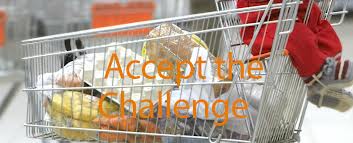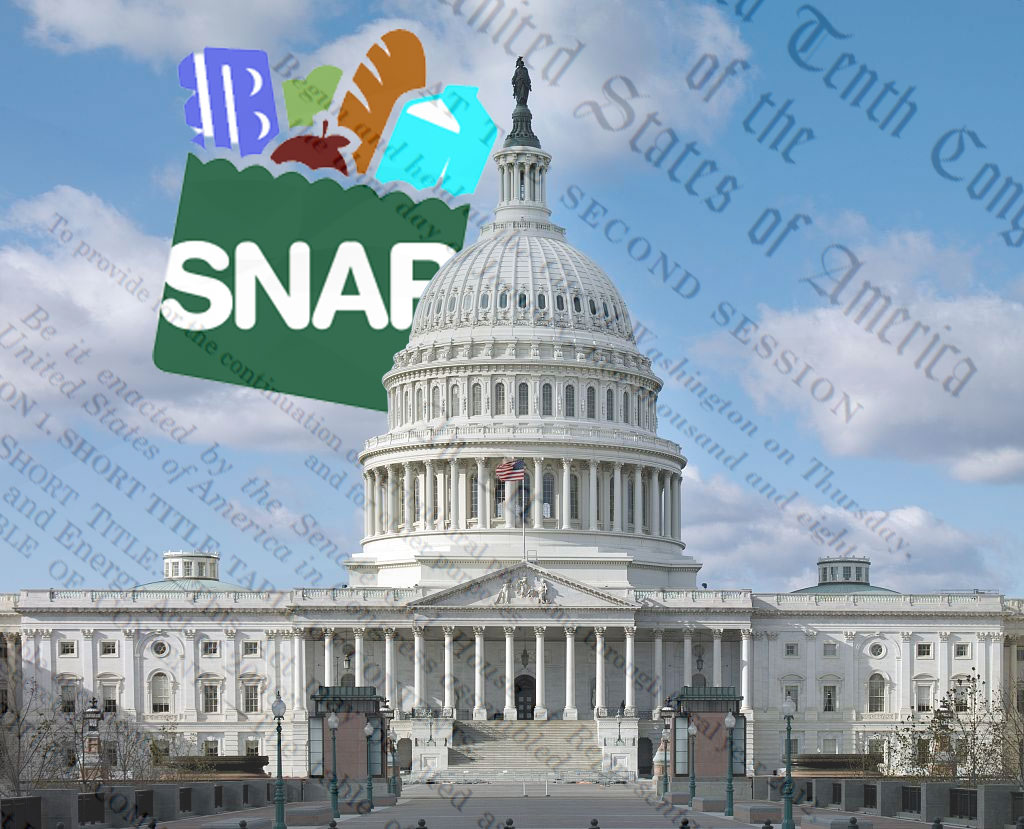A lot is being made of the current congress’ evil efforts to keep poor people from eating. I’ve talked about the problems with SNAP here before. If you’ve been stuck in a California Kitchen since the start of the year stuffing your face with expensive shitty pizza you may not have heard that SNAP is on a chopping block as a provision of the “Farm Bill”. Last week, the U.S. Senate voted down an amendment by Kirsten Gillibrand (D-NY) to restore $4.1 billion in food stamp cuts—by reducing corporate welfare to a handful of crop insurance companies, mostly based overseas. Only 26 senators voted “yes.”
In this case the blame doesn’t lie solely with the Republicans. Twenty-eight Senate Democrats joined with all voting Republicans to defeat this amendment. If these cuts are allowed around 500,000 low-income households will lose an average of $90 in monthly benefits.
One of the reasons given for cutting these benefits is of course, the cost to our national debt. And to be fair, the amount we are spending is no small thing. Since 2008, enrollment has increased by 70 percent, reaching a record 47.8 million this past December. Funding for the food stamp program—or, as it’s now called the Supplemental Nutrition Assistance Program (SNAP)—has doubled since 2008, hitting nearly $80 billion in fiscal year 2012
On top of broad-based categorical eligibility, in 2009, as part of the stimulus bill, the Obama Administration suspended SNAP’s work requirements for able-bodied adults. The suspension was to be only temporary and end in 2010. However, Obama’s last two budgets called for a continuation of the suspension. Instead of waiting for Congress to act, the Administration began issuing work requirement waivers.
Still, it seems like extreme douchbaggery to cut food allocations to the poor. People beneath the poverty line need to eat and SNAP helps feed them. It seems entirely reasonable to be pissed that the evildoers in congress cut the peasantry’s food allotments. However, I personally am not mad or even concerned that they are considering cuts. To me it seems like perhaps the best place to cut. And no, I haven’t been mind Jedi’d by the evil Sith lord. Let me explain.
Last year, after reading about several people who put themselves on a food stamp challenge for a month or longer to see what it’s like to live below the poverty level I thought it would be a great family teaching moment to do the same. It would, I thought, teach my family about cooking from scratch, shopping wisely and make good balanced choices. It would also; I reasoned teach them about how hard it was for me personally to start out. I began my adult life with the help of social services and what was at the time called Food Stamps. However, it seems a lot has changed since then.

I ended up having to scrap my special teaching moment when I realized that a family the same size as my household currently (five) who receive SNAP, actually has a lot more available resources for food than I do.
For a family of five, I generally spend about $400/month solely on food. In my state (CA) a family of five on public assistance receives $793/month (source: http://www.massresources.org/snap-benefits.html) I can’t even begin to imagine what a menu would look like if I had that much to spend solely on food. It certainly would likely result in less home cooked from scratch foods. I would likely be left with a surplus of SNAP benefits at the end of the month or, even more likely I would be giving food away.
However what I wouldn’t have would be enough money to make ends meet in other areas. I wouldn’t be able to afford rent in my area nor would I be able to afford little “extras” like gas to drive my car or clothing to cover a growing family at a reasonable rate or even toiletries.
One of the main reasons given in the argument on Capitol Hill for keeping the food allocations where that are at is that it stimulates economy. Helping everyone by putting money into people’s hands and thereby into the hands of retailers, manufacturers, farmers, etc.
In commenting on the Bush tax cuts and the overall state of the economy, Rep. Hoyer told reporters last week that the continuance of funding government welfare programs is vital to a struggling economy. “If you talk to economists,” Hoyer contended, “they will tell you there are two things that are the most simulative that you can do — one is unemployment insurance, the other’s food stamps, okay?”
“Why is that?” Hoyer posited. “Because those folks who receive those resources must spend them. And they’ll spend them almost upon receipt.”
Of course, the ideology that government spending, particularly in the area of welfare spending, helps stimulate economic growth is not a new phenomenon, this line of thought exemplifies the tired old Keynesian economic theory
This is very similar to the idea that coal barons had when they set up company housing and company stores and paid miners in wages that could only be spent at company stores. The government is still making an assumption that they know what’s best for you and how and where you should spend your money. Are you thinking of saving for a car so you can get around to job interviews? Too damn bad because you are going to get SNAP and snap only pays for Kool-Aid and cheese. (And other foodstuffs obviously)
It is in this way lawmakers let the poorer amongst us feel like they care: “We don’t want anyone to starve.” While keeping you in your place. “You are poor, you don’t need a car.”

Lawmakers are able to sell this to the public by making taxpayers feel like their money that goes to social and welfare programs is being protected. There are “rules” around SNAP. Nobody is going to waste your precious taxpaying dollars on things they don’t need, it will only be used on edible things. This makes everyone feel good and happy that their tax dollars are being wisely managed. (Except for those in line at the grocery fuming about people buying steak with SNAP) After all, most of us want to help people, we even don’t mind giving change to those on the street we just like knowing it isn’t going to ripple or bath salts or whatever.
The reality is there are many ways around this. People are resourceful and for every rule there is a way around it. People convert SNAP items into cash all the time. The easiest way is through trade. Trading at a sort of street-trade rate folks will trade say $10 of SNAP credit to someone they know for $5.00 cash. Another way to get cash for SNAP is to buy a high ticket item like coffee or luxury foods and return them for cash.
You know that nice Tamale Lady who comes to your office and sells a dozen tamales for $20? She’s found a way to turn her SNAP into cash too.
But why would somebody do this? Because they have an excess of SNAP dollars and not enough money to pay their energy bills or buy diapers or get gas in their cars. The same family that receives $793 in SNAP aid gets a maximum aid payment of $966.00. (Source: http://www.cdss.ca.gov/cdssweb/entres/forms/english/temp2250.pdf) Maximum has a lot to do with what support programs you are able to attend and what outside work one is able to do.
Now, with that $966.00 you have to pay for your housing, auto, utilities, clothing, cleaning products, toiletries, etc. Taking into consideration the average cost of a two bedroom apartment in CA is between $750 and $900.00, that leaves a family with very little money, but a surplus of food.
“According to an excerpt from the senate budget committee’s new presentation, nearly one-in-three US residents receive government assistance — and that’s not even including those benefitting from Social Security or Medicare” (source: http://www.statisticbrain.com/welfare-statistics/) “Over 100 million people in the United States are now receiving some form of federal welfare, GOP reps claim, a figure they’ve found after combing through statistics collected from the US Census’s Survey of Income and Program Participation. Paired with recent figures out of the Census Bureau, that brings the percentage of people residing in the States receiving some form or another of federal welfare at nearly one-in-three, given that the country’s population is estimated to be around 314 million, according to the department’s most recent statistics.
The committee’s findings actually put the figure of US residents on welfare close to around 107 million, which appears substantial when compared to statistics from only a few years ago. During the first quarter of 2009 when Barack Obama was inaugurated as president of the United States, roughly 97 million US residents were on the receiving end of federal programs.
And although the committee’s research does not take into account Social Security and Medicare, the SNAP program more than makes up for that exclusion: the study finds that the number of American receiving SNAP benefits have doubled in barely a decade.”
““Among the major means tested welfare programs, since 2000 Medicaid has increased from 34 million people to 54 million in 2011 and the Supplemental Nutrition Assistance Program from 17 million to 45 million in 2011,” the Senate Budget Committee reports. Researchers add that they expect spending on SNAP to reach $800 billion during the next ten years.” (Source: http://rt.com/usa/million-us-residents-welfare-268/)
For those of you who like me relate real life to movies, take a look at the movie “The last days of Disco” Almost every highly educated adult-child in that movie ended up on public assistance by the end. Was it their fault? A little bit, but also, the times were a changin’ and the jobs they went to school to qualify for were no longer available. Also internet blogging had not yet been invented and they were lazy or fish out of water or whatever socially acceptable word you want to insert. The point is: They were unprepared and under qualified to do multiple jobs. The party ends and young people don’t plan for this. Or rather, they haven’t in a while and a shift needs to happen.
This social benefit (And yes- “welfare” is a benefit you pay for while you are working so it is an entitlement to a certain extent.) is in reality a trap. The System traps people because it does not allow for any upward mobility. If you heaven forbid, find work you will lose SNAP benefits. You will also lose cash benefits as well as any low income (HUD) housing vouchers you may have and childcare vouchers if you are lucky enough to live in an area where these are available. And yes, those on public assistance do receive help with childcare even when they may not need it. This is due to the fact that some wiley law makers don’t think poor people should raise their children regardless of whether they actually have jobs or are in a training program or not. It wouldn’t do to let such miserable failures raise their own children would it?
There are answers however. Instead of overfeeding the poor, how about making life in general more affordable? If, for whatever reason someone is unable to work, wouldn’t it be better if they had their rent and utilities covered? How about putting science and technology to work for social welfare by diverting some of the money spent on SNAP to things like Solar Power in HUD housing? Instead of requiring people to sit through videos about how to buy good food on SNAP how about setting up apprenticeships that will lead to long term work. That would be a win for both the apprentice and the trainer.
If we expect at anytime to live in a healthier manner, we need to take the emphasis off of food procurement (solely) and put it on becoming more symbiotic in all of our dealings. If those of us who are doing alright are giving a leg up to others on a regular basis everyone benefits.
So I am fine with cuts to SNAP. Just not in order to balance any sort of a budget; because let’s face it a budget is a crazy impossibility at the level of money our nation is working with anyway. I am in favor or reallocating to make life more livable for everyone. It does nobody any good to be eating like a king while camped out in a cot at the local national armory.
http://blog.heritage.org/2013/04/04/wsj-food-stamp-rolls-remain-high-despite-economic-improvement/



The biggest fault in your argument is that different states have different guidelines for allotments and services. The maximum amount a single person with zero income in my state can receive is $264. Groceries are so expensive, one person can spend a hundred dollars a week on some pretty basic food items; hamburger, stew meat, a few fruits and vegetables will immediately rack up the first one hundred dollars. Most food stamp recipients also use the food banks to make it through the month.
We do have low-cost housing based on income. Someone working at a fast food joint making eight dollars an hour can rent a nice apartment for less than two hundred a month. Not everyone is agreeable with this option however, as all applicants are carefully screened. If you are renting a two-bedroom apartment, you can’t choose whatever room-mate you want; the room mate is also screened for approval. You may not have guests over for more than one night, there are strict rules of conduct and you may not own pets. In other words, they don’t feel like they are renting a home, but borrowing a place to stay for awhile.
Because of our harsh winters, some type of housing is absolutely necessary. What is sad though, are the number of people with very poor housing but that can’t get help because the housing, no matter how shabby, is their own. If it belongs to you, you’re shit out of luck. Cope with it in any way you can or sell out and opt for public housing.
Our biggest problem is transportation. We have an inadequate bus system and commuting to jobs is common. For those who own a vehicle, the cost of gas and maintenance take half their income. For those who do not, the only choice is to find a job close to where they are living and walk or ride a bicycle. There are many people who walk up to eight miles a day, to and from work, even in below zero weather.
A little free food is a comfort zone for a population that is staggering under the effects of not having their true needs met. I agree, there needs to be more concentration on covering other needs beside eating, but I am afraid that if more of a safety net is not in place, citing SNAP abuse as a reason to take food away will simply remove the one dependable comfort.
The arguement I was making was not that SNAP should be cut due to abuses. I don’t even call them abuses but rather, necessities. People work the system because they have to. That is unacceptable from a socially responsible standpoint. We should be thinking of evening the allocations so none of that is necessary.
I can see where it would be hard to get the food necessary for one person on $264/month in a place like Alaska where food is harder to get, needs to be shipped and is more expensive. Alaska is unique and to my thinking one gives up certain things like inexpensive food when they opt to live rurally on what is still the frontier.
However, in most of the nation this is more than enough. It’s more than half of my food budget for 5 and we eat pretty well. In addition I would argue that people are not meant to live alone without a supportive system. Ideally there would be more than one person pooling food and other resources communally. The fact that this is also made difficult when receiving aid is a problem. But that’s a whole different bag of worms.
The entire Farm Bill is problematic and should be looked at closer. This hoopla with SNAP is a bait and switch for agencies like Monsanto. When it passes SNAP, I’m sure will be just fine, we will just be feeding poison to the poor. What is in my hopes and dreams is that we can begin to give in places where it actually helps people rather than keep them in perpetual stasis.